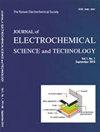新型微刀片切削方法在复合电极粘接测量中的应用
IF 3
4区 工程技术
Q3 ELECTROCHEMISTRY
Journal of electrochemical science and technology
Pub Date : 2021-12-17
DOI:10.33961/jecst.2021.00976
引用次数: 0
摘要
微刀片切割方法,即所谓的SAICAS,被广泛用于量化不同深度的电池复合电极的粘附力。然而,随着电极厚度或负载的增加,通过传统方法测量的粘附值的可靠性越来越受到质疑。因此,在本文中,一些被低估的参数,如摩擦、变形能、侧面积效应和实际喷丸面积,都是用135µm(6mAh cm-2)的超厚复合电极仔细研究的。其中,发现侧面区域的存在和实际剥离区域的变化对测量的水平力有显著影响。因此,特别是对于超高电极,我们可以设计一种新的SAICAS测量标准:1)侧面区域应该预先切割,2)必须确保相同的实际剥离区域,以在不同深度获得可靠的粘合。该指南将有助于为高能量密度电池设计更坚固的复合电极。本文章由计算机程序翻译,如有差异,请以英文原文为准。
A New Perspective on the Advanced Microblade Cutting Method for Reliable Adhesion Measurement of Composite Electrodes
The microblade cutting method, so-called SAICAS, is widely used to quantify the adhesion of battery composite electrodes at different depths. However, as the electrode thickness or loading increases, the reliability of adhesion values measured by the conventional method is being called into question more frequently. Thus, herein, a few underestimated parameters, such as friction, deformation energy, side-area effect, and actual peeing area, are carefully revisited with ultrathick composite electrodes of 135 µm (6 mAh cm -2 ). Among them, the existence of side areas and the change in actual peeling area are found to have a significant influence on measured horizontal forces. Thus, especially for ultrahigh electrodes, we can devise a new SAICAS measurement standard: 1) the side-area should be precut and 2) the same actual peeling area must be secured for obtaining reliable adhesion at different depths. This guideline will practically help design more robust composite electrodes for high-energy-density batteries.
求助全文
通过发布文献求助,成功后即可免费获取论文全文。
去求助
来源期刊

Journal of electrochemical science and technology
ELECTROCHEMISTRY-
CiteScore
6.30
自引率
8.10%
发文量
44
期刊介绍:
Covering fields:
- Batteries and Energy Storage
- Biological Electrochemistry
- Corrosion Science and Technology
- Electroanalytical Chemistry and Sensor Technology
- Electrocatalysis
- Electrochemical Capacitors & Supercapcitors
- Electrochemical Engineering
- Electrodeposition and Surface Treatment
- Environmental Science and Technology
- Fuel Cells
- Material Electrochemistry
- Molecular Electrochemistry and Organic Electrochemistry
- Physical Electrochemistry
- Solar Energy Conversion and Photoelectrochemistry
 求助内容:
求助内容: 应助结果提醒方式:
应助结果提醒方式:


